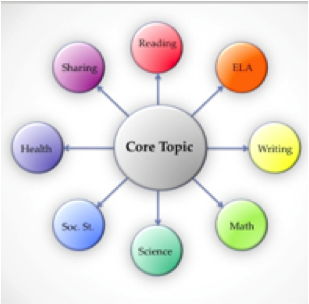Transformational Perspectives: Scriptural Underpinnings of Transformational Education with a Christian Worldview
For the Christian educator, be that person a teacher or leader, the primary goal of teaching and learning is to present everyone mature in Christ[1]. Christian education fosters maturity in Christ, preparing students for both life beyond school and eternity, for honouring and glorifying God.
The first Scriptural underpinning for this is the Great Commission. In Matthew 28:16-19, Jesus states “Therefore go and make disciples of all nations, baptizing them in the name of the Father and of the Son and of the Holy Spirit”. The global perspective that Christian education should hold is clear; all nations and all cultures are to be baptized and made disciples. Thus an understanding of how the world works, and how people, cultures and nations interact with each other, is important if the goal of Christian education, the presentation of everyone mature in Christ, is to be realized.
One way such a goal is realized through teaching everyone with all wisdom. This means that all learners receive a quality teaching and learning experience. Christian learners are prepared to impact their world for Christ and non-Christian learners are shown a meaningful faith that possesses at its core an intellectual credibility applicable to the wider world.
Thus, the learner is the focus of Christian education. Each learner is considered unique as he or she is made by God[2]. Learners are also acknowledged to be complex, entering the classroom at different stages in their learning, with different experiences, and different levels of knowledge or skills. Christian educators recognise the complexity in all learners and that they are God’s handiwork, created in Christ Jesus to do good works, which God prepared in advance[3]. Thus, Christian education is something that helps learners mature by unwrapping their God-given gifts so that they can find their place in service of others and have an impact on the world for Christ.
In the closing remarks of his letter to the church at Philippi, Paul exhorts Christians to strive for excellence[4]. His point is made on an understanding of human nature. To dwell on matters not conducive to a healthy mindset adversely affects thought, character and action. It stunts maturity in Christ. For the Christian learner, Philippians 4:8 makes a clear call to excellence as the standard for living a Christian life. For the non-Christian learner, the call for excellence in all things deflects criticism that in some way, shape or form, Christian education is not good enough, that it is in some manner deficient or irrelevant.
Additionally, Paul reminds us that we are called to be Christ’s ambassadors[5]. Such a description is no small thing, for an ambassador is someone who represents the interests of his or her nation in a foreign country, someone who is completely knowledgeable about whom they represent and their worldview. In the context of Christian education the directive from 2 Corinthians 5:20 calls schools to be prepared to represent God and His message faithfully and accurately in all that they do. Christians will attract the attention of those around them and so it is therefore critical that Christians act in the same manner as an envoy or representative. Teaching and learning programs must engage in the wider world knowledgably and with certainty about that message.
Education is therefore a life-long process[6]. It focuses on the intellectual, personal, emotional and social growth of the individual through all domains of knowledge[7]. Education prepares learners for a life of active, responsible citizenship with both a local and international outlook[8]. It instills in them a passion for lifelong learning, inspires them to excel academically, to work towards intellectual and emotional maturity and to ensure they are prepared for the world beyond the classroom[9]. Through Christian education, learners develop a deep subject expertise alongside the ability to engage with a diverse range of people, embrace both traditional and innovative thinking, and be able to bridge cultural boundaries genuinely. This is what we should strive after as we seek to develop learners who will be presented mature in Christ. This is transformational education.

Timothy Scott, Ph.D.
Director of Student Learning and Head Principal
Black Forest Academy, Germany
[1] Colossians 1:28
[2] Genesis 1:26-28; Psalm 139:14
[3] Ephesians 2:10
[4] Philippians 4:8
[5] 2 Corinthians 5:20
[6] 1 Timothy 4:13
[7] Proverbs 1-4; Romans 12:2
[8] 1 Timothy 2:2-8
[9] Philippians 4:8
Photo Credits: Great Commission. Christian Cross Clipart. Lab II. BFA.TeachBeyond.
Timothy Scott is the Director of Student Learning and Head Principal at Black Forest Academy (BFA) in Germany, where he leads the school’s academic program operating across three campuses and is involved in curriculum management and development, and student pastoral care. Additionally, Tim manages the partnership between BFA and several German Christian schools. He has a passion for teaching ancient history, historiography and philosophies of history, holding a PhD in the subject. Tim has 20 years of experience in education, having taught and held leadership positions in several large independent schools in Sydney, Australia.










 The way a teacher approaches this common scenario is one way a transformative classroom is different from one which is not. The transformative teacher will correct a student while also finding ways to establish the student as a child of God. The transformative teacher builds up all students in an honest way, recognising the God-given worth and value of each one. Just as a transformative teacher corrects the non-compliant child, helping him understand the motives behind the non-compliant behaviour and develop strategies to change his behavior, she also lovingly challenges the compliant child, encouraging him to examine the motives behind his behavior. (Is he good for the love of stickers? To be better than everyone else?)
The way a teacher approaches this common scenario is one way a transformative classroom is different from one which is not. The transformative teacher will correct a student while also finding ways to establish the student as a child of God. The transformative teacher builds up all students in an honest way, recognising the God-given worth and value of each one. Just as a transformative teacher corrects the non-compliant child, helping him understand the motives behind the non-compliant behaviour and develop strategies to change his behavior, she also lovingly challenges the compliant child, encouraging him to examine the motives behind his behavior. (Is he good for the love of stickers? To be better than everyone else?)









